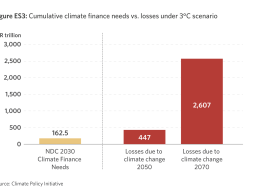As regulatory pressures mount and ESG (environmental, social, and governance) considerations take centre stage, businesses face growing scrutiny over their carbon emissions. Investors are increasingly prioritising sustainable portfolios, and consumers demand greener practices. Among the technologies emerging to address these challenges, Carbon Capture and Storage (CCS) is garnering attention as a viable tool for decarbonisation. With over 45 large-scale facilities already operational globally and a rapidly expanding market, CCS offers both opportunities and challenges for businesses aiming to align with net-zero ambitions.
CCS refers to the process of capturing carbon dioxide (CO₂) emissions from industrial activities and power generation, preventing them from entering the atmosphere. This three-step process begins with capture, where CO₂ is separated from other gases produced during industrial operations. Depending on the technology used, this can occur before combustion (pre-combustion), after combustion (post-combustion), or through oxy-fuel combustion, where fuels are burned in oxygen to simplify CO₂ separation. The captured CO₂ is then compressed and transported—typically via pipelines, but also by ships or trucks—to designated storage sites, where it is injected into geological formations such as depleted oil and gas fields or deep saline aquifers.
The global CCS market is projected to grow from $3.54 billion in 2024 to $14.51 billion by 2032, reflecting a compound annual growth rate (CAGR) of 19.29%. This growth highlights the increasing role of CCS in mitigating emissions from sectors where other decarbonisation technologies are not yet feasible. Industries like cement, steel, and chemicals are prime candidates for CCS, given their reliance on high-temperature processes that cannot easily be replaced with renewable energy. Additionally, CCS serves as a transitional technology, enabling fossil fuel-dependent systems to operate more cleanly while renewable energy infrastructure scales up.
The geographical distribution of CCS projects underscores its global relevance. As of 2024, the United States leads with 18 operational facilities, followed by China with 14, Canada with 5, and Norway with 2. Other countries, including Australia, Brazil, Qatar, Saudi Arabia, and the United Arab Emirates, each host one operational project. Norway’s Sleipner Project, operational since 1996, is a pioneering example of CCS in action, injecting CO₂ into a saline aquifer beneath the North Sea. Similarly, Chevron’s Gorgon Project in Australia is one of the largest CCS initiatives globally, capturing over 4 million tonnes of CO₂ annually.
Despite its potential, CCS faces valid criticisms. One major concern is the high cost of implementation, with global investment in CCS estimated to require between $655 billion and $1.28 trillion by 2030 to meet climate targets. Additionally, CCS processes are energy-intensive, often increasing a facility’s energy demand by 10–40%, depending on the technology used. Critics also highlight the risk of CO₂ leakage, although advancements in site selection, monitoring, and containment technology are designed to minimise this risk.
Another significant criticism is that CCS may prolong reliance on fossil fuels, diverting resources away from more transformative solutions like renewable energy. Public perception further complicates deployment; communities near proposed storage or transport sites often express concerns about safety, potential leaks, and long-term reliability. Transparent communication and stringent regulations will be key to addressing these concerns.
Innovations in CCS technology are addressing some of these criticisms. Direct Air Capture (DAC), for instance, removes CO₂ directly from the atmosphere, offering a complementary solution for offsetting emissions from diffuse sources. Companies like Climeworks are leading the charge in developing DAC systems. Similarly, advancements in CO₂ utilisation—where captured carbon is converted into products such as synthetic fuels, plastics, and building materials—are expanding the economic potential of CCS. These innovations create opportunities to turn emissions into assets, reducing reliance on geological storage.
Nature-based solutions also play an important complementary role. Initiatives like reforestation, wetland restoration, and soil carbon sequestration absorb CO₂ while delivering additional benefits such as biodiversity conservation and flood protection. Although generally less expensive than technological CCS, these solutions face challenges like land availability and vulnerability to climate change impacts. Combining nature-based and technological approaches can create a more holistic strategy for addressing emissions.
The role of governments, corporations, and investors in advancing CCS is crucial. Governments are driving adoption through subsidies, funding, and regulatory frameworks that incentivise businesses to invest in the technology. For example, the oil and gas industry accounts for 90% of the global CCS capacity currently in operation, much of which is supported by government incentives. Corporations are incorporating CCS into their decarbonisation strategies to align with regulations and ESG goals, while investors are recognising CCS as an opportunity to achieve environmental impact alongside financial returns.
For business leaders, the return on investment (ROI) in CCS is an important consideration. While costs remain high, revenue streams from carbon credits and the sale of captured CO₂ for enhanced oil recovery (EOR) or industrial uses can offset expenditures. Additionally, implementing CCS can help companies avoid penalties associated with emissions regulations and position themselves as leaders in sustainable innovation, enhancing their brand reputation and competitiveness.
Looking to the future, the CCS landscape is set to evolve rapidly. Global capture capacity has been steadily increasing, with significant growth observed between 2010 and 2023. The market’s trajectory suggests that businesses that act early could secure a competitive advantage, particularly as climate regulations tighten and carbon pricing becomes more widespread. However, the technology’s role should be seen as complementary rather than central to the energy transition. CCS is most effective when deployed alongside renewable energy, energy efficiency measures, and nature-based solutions.
For businesses considering CCS, the path forward involves careful evaluation of their carbon footprints and sector-specific challenges. Collaboration with governments, technology providers, and other stakeholders can help share costs and risks while accelerating deployment. Transparency and public engagement will also be critical to building trust and securing community support for CCS projects.
CCS could be a promising tool in the fight against climate change, offering potential pathways to address emissions from hard-to-abate sectors. However, it is not without limitations, and its success will depend on strategic implementation, continued innovation, and robust regulatory oversight. For business leaders and investors, CCS represents both an opportunity and a challenge—a technology that can contribute to sustainability goals while requiring thoughtful consideration of its economic and environmental implications. The time to explore its potential is now. By integrating CCS into a broader portfolio of climate solutions, businesses can position themselves to navigate the complexities of the energy transition effectively and responsibly.




















